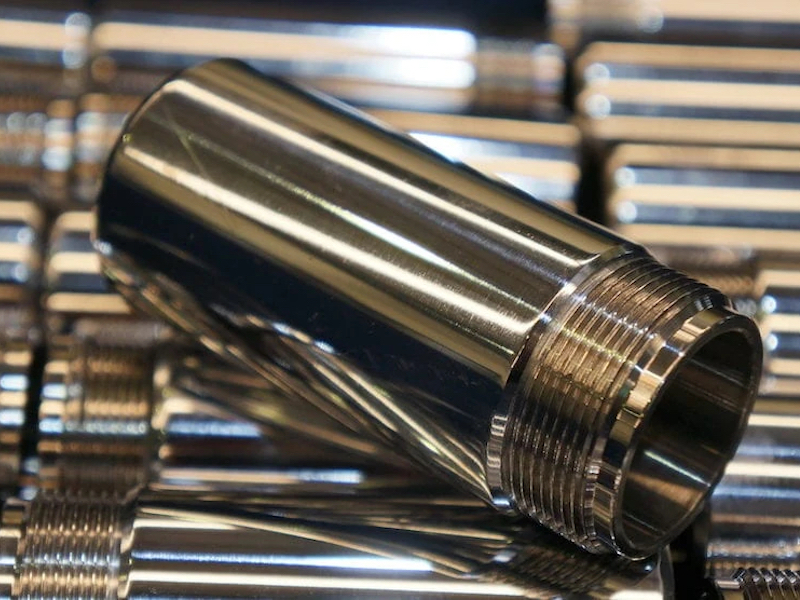Nickel is one of the oldest metals known to mankind and has been used in various applications for over 5,000 years.
 Stephen F. Rudy CEFCurrently, mobile phones, computers, electrical power generation, automotive, clothing and apparel, medical equipment, food preparation, plumbing ware, pharmaceutical production, construction, and military all are heavy use examples for nickel. Stainless steel, in alloys, contains varying amounts of nickel.
Stephen F. Rudy CEFCurrently, mobile phones, computers, electrical power generation, automotive, clothing and apparel, medical equipment, food preparation, plumbing ware, pharmaceutical production, construction, and military all are heavy use examples for nickel. Stainless steel, in alloys, contains varying amounts of nickel.
Our focus will be on substrates that are nickel-plated and nickel baths that provide the electrolytes to achieve the required nickel deposits for many applications and finishes. In every aspect of this review, bear in mind the expense associated with nickel anodes and plating salts. Be sure to know the facts and apply them properly. As we are all aware, nickel prices — be it anodes or salts — have risen steadily to new levels over the past twenty years. Even though the prices of nickel anodes and related salts have increased sharply, the importance of nickel in plated finishes is still of great significance. More importantly, these finishes are still in demand.
Necessary for Various In-Demand Finishes
Referring to plating baths, each provides specific benefits that, regardless of cost, have become necessary for various in-demand finishes. These include decorative, functional, wear resistance, and corrosion protection. Nickel encompasses many plating systems, each of which is very important to many aspects of metal finishing. Let us review some pertinent facts regarding practical nickel plating. The information should balance or support the need for nickel plating, even if the finishing cost has increased.
For industrial purposes, almost any metal can be nickel-plated. The inherent properties of nickel can be combined with the unique properties of other metals. Some examples of metals commonly plated with nickel are steel (high strength), brass (easily bent and formed), aluminum (impact extrusion), and die castings (design flexibility). Plastics, which have been treated for conductivity, are also commonly nickel plated. Nickel can be directly plated over several metals. This is commonly performed directly over steel, brass, and copper. In some cycles, appropriate immersion treatments or preplate deposits precede nickel. This is especially prevalent when plating a copper strike and copper plate over zinc parts before nickel. Aluminum, because of its unique electropositive nature, must first be conditioned by immersion zincating before plating either by electrolytic or electroless nickel, directly over the adherent zincate film.
The application of a suitable nickel deposit can be of significant benefit to the parts, the ultimate quality of the finish, and meet or exceed specifications. These advantages can actually reduce related manufacturing costs, improve marketability and increase production throughput.
Nickel Provides Several Advantages
Depending on the finishing requirements or service life of parts, nickel provides several advantages: good electrical conductivity, a low coefficient of thermal expansion, magnetic influence, variations of internal stress, tensile strength, ductility, and good heat conduction. Nickel can be plated as a soft deposit (not far off from copper) or almost as hard as chromium. In fact, nickel can be plated to almost any desired deposit hardness in between this wide range. Aesthetically, nickel can be plated in decorative applications to achieve a wide range of brightness and leveling, still retaining sufficient deposit ductility.
Finished parts can be assembled or mechanically formed into selected commercial products. Along with these benefits, duplex nickel forms an excellent corrosion barrier, especially in the plating of exterior automotive parts. Nickel deposits form an important barrier to prevent the migration of copper on tin-plated brass or copper parts. In engineered finishes, nickel decreases contact resistance and friction. Solderability and brazing are improved. Resistance to galling and wear is also enhanced. Plating with nickel can salvage worn or mis-machined parts. This is also achieved by electroforming. Almost all nickel deposits can be machined. Incorporating nickel into the deposit in place of solid metal reduces some related manufacturing costs.
Nickel can be plated to provide rapid leveling, filling voids, and eliminating microscopic “peaks and valleys” while plating a relatively thin deposit. For this reason, the basis metal may not have to be mechanically polished, buffed, or mass finished. If this is acceptable, cost savings to prepare the surface for plating may be realized, along with savings to plate less nickel. Nickel can be plated from different specific bath formulations (commonly Watts and sulfamate types) to develop deposits that range from flat to dull to semi-bright to bright. This affords the finisher the capability to provide nickel deposits that meet engineering requirements, corrosion protection, and aesthetic preferences. The Woods strike effectively activates stainless steel for subsequent nickel plating. Duplex nickel, as mentioned earlier, promotes exceptional corrosion protection by plating a balanced ratio of semi-bright (especially formulated for this purpose) and bright nickels. The Step Test is a specific quality control procedure for this application. In recent years Watts baths containing modified organic additives have successfully replaced cyanide copper strikes over zincated aluminum.
Decorative Chromium Specified Finish Over Nickel
Decorative chromium, either the more prevalent trivalent bath or traditional hexavalent, continues to be a specified finish over nickel. The chromium topcoat enhances its overall appearance and maintains an excellent scratch-resistant, hard finish. Although we commonly refer to it as the bright chromium finish, it is primarily nickel (usually bright) with a thin chromium flash. The combination of these deposits gives the assembled parts a preferred pleasing appearance, along with exceptional corrosion and wear resistance. For several decades, the combination of bright nickel and flash chromium has been the best selection for plating parts subject to outdoor exposure. That is, until the advent of alloy zinc technology, which has become an alternative for functional applications. For aesthetics, powder coating has also become quite popular.
Nickel can be plated as a very ductile deposit, in combination with a proper basis metal conditioning and any preplate deposits. The finished items can be stamped, drawn, or formed in a variety of shapes. This is very common in the strip plating of continuous coils that will be used in the manufacture of different types of consumer and industrial goods. In this application, the organic brightener and leveling additives may be kept at lower levels to achieve the required ductility. The final aesthetic appearance of nickel occurs in a short buffing cycle before optional chromium plating. Parts that require exceptional brightness and leveling may be stamped before the plating cycle.
Nickel can be plated to meet any thickness requirement. Industrial-based coatings usually require 0.005 to 0.020 inches. For decorative purposes, nickel deposits may range from 0.0003 to 0.001 inches (or up to one mil). As indicated by the application ranges, there is a minimum that should be plated to meet the intended use of finished parts. As a guide, one pound of plated nickel is required for every 22 ft2 of intended parts coverage. Depending on the nickel bath and plating parameters, the deposit tensile strength can range from 50 to 220 thousand lb/in.2.
Cost Factor
Nickel anodes are expensive. Be certain that the certificate of analysis confirms the quality. Anything less than sufficient purity material could result in severe contamination of the nickel bath. A typical assay is: nickel (99.950%), cobalt (0.03%), copper (0.005%), carbon (0.001%), iron (0.001%) and sulfur (0.01%). Incidentally, one may wonder why there is cobalt in the assay. That is because nickel and cobalt, as elements, are similar in their electron densities. The title of this article describes Nickel atomic number 28. Cobalt’s atomic number is 27. Anodes are provided in various shapes, including spears, buttons, rounds (sulfur-containing S and sulfur-free R), pellets, and chunks.
There are many applications for plating nickel, using several types of process baths. The demand for nickel plating continues to be relatively strong. Although the prices for nickel anodes and salts have markedly risen, the consumer market for plated finishes keeps this plating service very active. Bright nickel/chromium finishes are popular in the sporty automotive / motorcycle market. The decorative plumbing industry is very positive about nickel/chromium and brushed nickel finishes. Clothing and apparel manufacturers now feature nickel finishes (e.g., oxidized, brushed, under flash brass or gold). Decorative and industrial finishes for nickel are in strong demand. The future outlook continues to favor nickel-containing finishes.
Stephen F. Rudy, CEF, is president of Chem Analytic, and has written extensively about the finishing industry. Visit www.chemanalytic.com or call him at 917-604-5001.



































